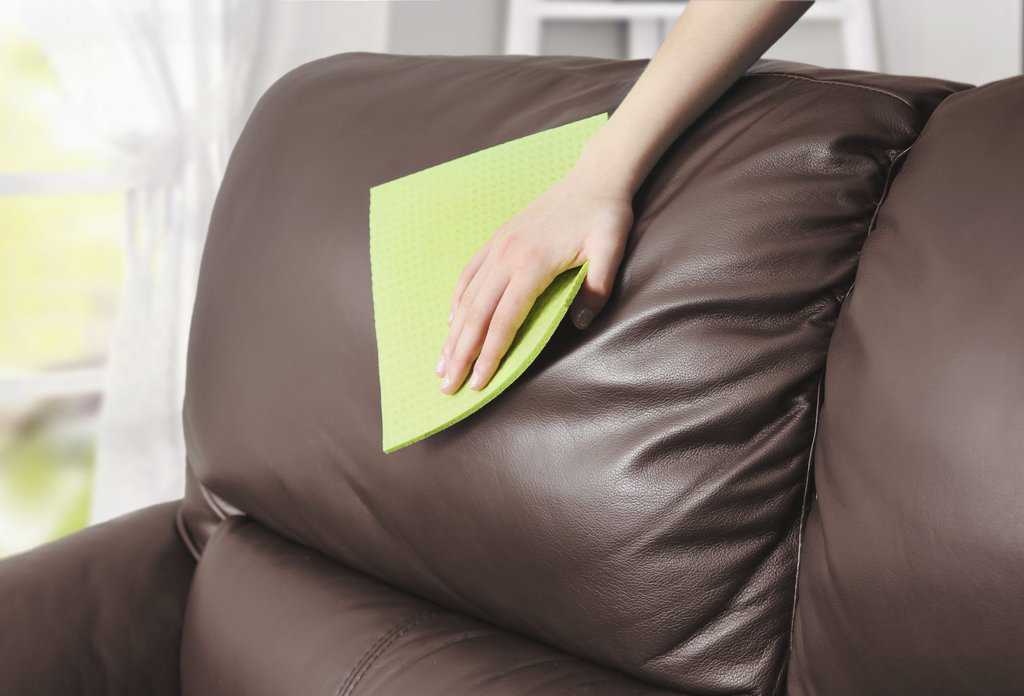No item or surface is immune from germs and viruses, and this includes leather. If you want to make sure that your leather furniture is free from bacteria that can cause diseases like COVID-19, you should know how to disinfect them properly without running the risk of damaging the material. In this article, we’ll talk about which disinfecting products are safe or unsafe for leather and how you can use them effectively to reduce the risk of damage.
Antibacterial leather
There are leathers that are naturally antibacterial. Take note, however, that not all leather is antibacterial. There have been studies on the antibacterial properties of leather that is vegetable tanned.
Vegetable-tanned leather and its antibacterial properties
In this German study from the International Union of Leather Technologists and Chemists Societies (IULTCS) about the antibacterial properties of leathers tanned with natural tannins, they found that the tannins, that the plants use to defend themselves against bacteria, also continue to do the same job in leather.

The researchers have found that tannins from Chestnut, Quebracho, and Tara, when used to tan leather are able to make the leather antibacterial.
We cannot say for sure if other types of vegetable-tanned leather that are not tanned with those three mentioned above are antibacterial. However, if you are able to find out what type of tannins were used in the production of the leather you’re looking to buy, then it might be a great deal (10-20% of all leather is vegetable tanned).
Chestnut, Quebracho, and Tara are some of the most common types of tanning agents when it comes to vegetable tanning, so it might be a good bet to buy yourself vegetable-tanned leather as opposed to chrome-tanned or other methods that have not been proven to give leather antibacterial properties.
Benefits of antibacterial leather
The researchers have done tests on shoes, and they have found that because of the antibacterial properties of the vegetable-tanned leather, it is able to fight unpleasant odors caused by bacteria from foot sweat.
When it comes to leather shoes, it is quite well-known that Cedar wood shoe trees help absorb that sweat and prevent shoe odors. But, we might have missed that the leather itself also does the same thing. It may not be such a good idea to not use shoe trees on your precious oxford shoes, however, as they serve to keep the shape and absorb the sweat instead of the leather absorbing the sweat.
Sweat may still break down the leather even if the bacteria die due to sweat’s acidic nature.
How to disinfect leather Couch
Disinfecting leather couches and other leather goods can be quite difficult as most disinfecting products are quite harsh. We have compiled a list of different products that most people may look towards when they want to disinfect a surface or an item. It is quite difficult to find a completely safe leather disinfecting product. Most leather wipes aren’t even rated for disinfection, but you are able to use a few products given you use them with caution and watch out if it reacts badly to the leather or not.
Leather Repair Company Anti Bacterial Spray – Safe for leather
This anti-bacterial spray is specially made to be leather-friendly and it has a broad-spectrum biocide to get rid of germs and prevent them from coming back. However, since this spray is professional grade, it is more powerful than the normal antibacterial sprays and should be used with caution, especially if you have kids or pets.
You can use this sanitizing spray for leather couches, shoes, or jackets. This can also be used on leather car seats, but make sure to ventilate your car afterward. Here’s how to use the Leather Repair Company Anti-bacterial Spray:
- Shake the bottle before using it.
- Spray it onto the leather surface that you want to disinfect and make sure to let it sit for a few minutes.
- Wipe away the excess moisture using a microfiber cloth and you’re good to go.
Microban Interior Detailer – Safe for leather
Adam’s Microban Interior Detailer is designed for cleaning and disinfecting car interiors. The great thing about this all-purpose spray is that aside from being able to clean almost any type of surface, it is also safe for leather materials. If you’re planning to disinfect your leather car seats, we recommend this product since it also has UV-blocking and anti-static features to prevent dust build-up.
All you need to do is spray the Microban Detailer onto the surface that you want to clean and wipe it using a soft towel in circular motions. You should also know that this product gives off a matte finish, so if you want to restore the gloss or shine on your leather item, be sure to apply leather conditioner once you’re done.
Alcohol – Use with caution
Alcohol is probably the first thing that comes into most people’s minds when they think of the word “disinfect” or “sanitation.” However, alcohol is not something you should use on leather so willingly.
Alcohol can dry out leather and strip its natural oils which can put your leather item at risk. Leather that is dried out can wrinkle more easily and even crack if not reconditioned.
If you want to disinfect using alcohol, use a cloth and wet it with the alcohol. You can then use the cloth to wipe the surface clean. This is to avoid the alcohol from absorbing into the leather too much. With this method, you may not need to recondition as only the surface is touched by the alcohol and it does not go deep into the leather.
However, if you want to disinfect the leather deeply for any potential viruses that have embedded themselves into the leather, you may use more alcohol directly onto the leather material. Make sure to test it first to make sure it does not interact with any dyes or cause discoloration.
After the alcohol has been absorbed into the leather, give it some time to evaporate completely for about 5-10 minutes. Once that time is over, go over it with a leather conditioner to return its nourishing oils and moisture to avoid cracking or excess wrinkling due to the dried-out leather.
Dettol Antiseptic Liquid – Use with caution
Dettol liquid is a popular multi-purpose antiseptic that can even be used to clean wounds and cuts just as much as home surfaces. One of the best features of this product is that it is proven to kill viruses and bacteria very effectively, including COVID-19.
It is a hospital-grade product so it is very strong straight from the bottle. However, for home cleaning use, it is indicated that you should dilute it.
As Dettol contains Chloroxylenol, Isopropanol, and soap, it will dry out the leather. Surprisingly enough, it also contains castor oil, which is actually pretty good for leather. However, the castor oil in Dettol is only in very small amounts.
To use Dettol liquid, it is best to dilute it. We recommend using 1 capful of Dettol in 3 cups of warm water. Do not pour this liquid directly onto the leather, use a clean cloth and dip it into the liquid, and test it in an inconspicuous area first. If there are no stains or discoloration, that’s when you know it’s safe to use.
Just in case it dries out the leather, go over the leather with a light coating of conditioner. However, you may not need it as it is a diluted solution. But we would advise you to do so if your leather item has not been conditioned for a while.
Lysol Disinfecting Wipes – Use with caution
Lysol disinfecting wipes aren’t recommended for leather. They may stain the leather or even affect the dye. They also run the risk of drying out the leather which may cause it to crack.
We would recommend this much more for faux leather as it practically runs no risk to the material and is very easy to use. However, if you want to use it on real leather, don’t do it. Rather choose one of the best leather wipes on market.
These wipes shouldn’t really be used for grain leather bags that are porous in nature like nubuck. They are best for smooth and shiny leather types like the ones you find in car seats or leather upholstery. You should also have a clean microfiber cloth at the ready to wipe off any excess liquid that may be left behind by the wipes that could stain the leather if left for too long.
Hydrogen peroxide – Use with extreme caution
Hydrogen peroxide can indeed be used to disinfect leather and it can also remove bad odors, molds, and stains. However, the risks are greater than the potential benefits when it comes to this solution as its oxidizing agent is very powerful. If you’re not careful, this could lead to leather dryness, discoloration, and weakening of its fibers.
Be sure to follow these steps if you plan on using hydrogen peroxide to disinfect leather:
- Dilute the hydrogen peroxide with equal parts water and no less.
- Transfer it to a spray bottle and spray it onto the surface about 10 inches away so it’s not so concentrated.
- Let it sit for about 5-10 minutes only.
- Wipe the area softly using a microfiber cloth.
- Dampen a soft towel with water and wipe the surface to remove any hydrogen peroxide residue. Be thorough with this step.
- Apply leather conditioner to restore its moisture.
Lysol Disinfecting Spray – DO NOT USE (faux leather with caution)
Lysol disinfecting spray is much too strong to use on leather. It has been known to cause discoloration and staining, especially on grain leather items. Grain leather items are very precious and expensive items that are usually hand-crafted. We would not want you to ruin those items as they are made with a lot of passion.
Lysol sprays are usually most recommended for hard, non-porous surfaces that do not absorb the spray. However, you may be able to use them on faux leather. Faux leather is usually non-porous, and even if they are, the spray will not ruin them.
Faux leather does run the risk of getting stained by the spray, so be sure to test it first in a discreet area. You may then spray and wipe to disinfect your item.
Clorox Wipes – DO NOT USE (faux leather with caution)
Clorox wipes are a popular disinfecting product that can be used for various surfaces that people touch. However, they are mostly meant for hard and non-porous surfaces. They are not meant for things like leather that can absorb liquid.
Clorox wipes contain harsh cleaning chemicals that can stain your leather items quite easily, especially if the leftover liquid after you wipe stays on the leather for a long time. Most people don’t usually think to wipe that off.
We recommend this only for faux leather as it doesn’t really pose a threat to faux leather, but you may want to test it first as it may affect the color of the faux leather item.
Bleach – DO NOT USE
You should never use bleach on any type of leather– whether it’s faux leather or real leather. Bleach is much too strong even if you dilute it with water and it will definitely ruin your leather item for good. It will strip away the natural oils and protective coating of your leather item even if it’s dyed with aniline for maximum durability.
One of the worst things about bleach is that it will stain your leather item immediately. It will also cause your leather items to become brittle and eventually crack. Once it starts cracking, it won’t be long until it starts peeling as well. We strongly discourage you from using bleach because it will also weaken the fibers, make them shrink, and remove the lubricants that make your leather item flexible.
Conclusion
Ensuring that your furniture and garments are cleaned and sanitized is essential for your and your family’s health. We hope that this article has given you enough information when it comes to disinfecting leather because you can’t just use any type of disinfecting solution as most of them are damaging to the material. That is why it’s important to know which products are leather-friendly and which ones are not.
FAQ
What should you not use on leather?
There are many things that you should not use on leather. We cannot name every single thing as that topic is much too long for a single article. However, as a general rule of thumb, if it is harsh and advertised as a strong cleaning product, you may want to avoid it.
For the safest options, you should use cleaning products made for leather materials. Those are usually formulated to be safe and effective for your precious leather goods.
What does dish soap do to leather?
Soap is designed besides other things to remove oils. Leather contains natural oils that moisturize and strengthen itself. When you use soap on leather, you end up removing those oils and drying out the leather when the water evaporates.
This can lead to very tough and hard leather that can wrinkle and crack easily. If you accidentally used soap on your leather items, you should condition it as soon as you can before the leather becomes brittle.
Saddle soap is a safer alternative as it contains nourishing fats and oils, but it may still dry out the leather for the same reasons. It is still best to use a leather conditioning product after using saddle soap.




